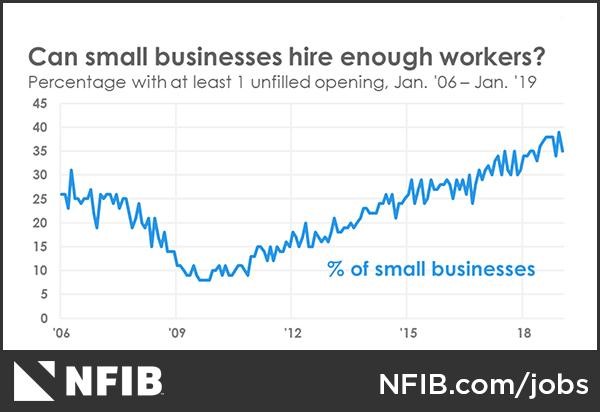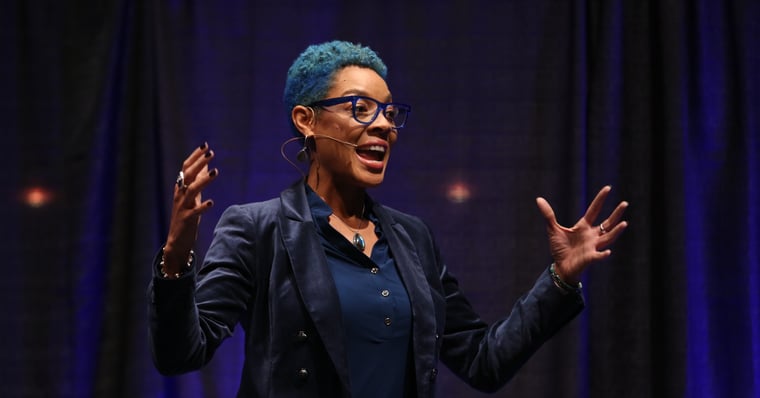It can be incredibly frustrating to have the potential to build your business or organization by boosting production and sales, but cannot seem to hire the workers you need to send your company into the stratosphere.
If you find yourself in this position, you’re not alone.
According to the NFIB Research Foundation’s January 2019 survey of 10,000 small businesses, 56 percent of owners were hiring or trying to hire, and a massive 88 percent of those owners reported finding few or no qualified applicants for the positions.
“There is a significant shortage of qualified workers that could slow down businesses,” says NFIB’s Chief Economist Bill Dunkelberg, “but for the most part owners are working hard to hire and attract qualified employees.”
Twenty-three percent of owners cited the difficulty of finding qualified workers as their single most important business objective while more than 35 percent of owners reported having job openings they could not fill (Figure 1). In fact, according to recent research by global organizational consulting firm Korn Ferry, media, tech, and telecommunications industries may be at a deficit of 1.1 million skilled employees across the globe by 2020. Competition is high, salaries are going up, and recent graduates are often flush with academic success, but have limited experience and even lower applicable skills.

In this marketplace, hiring someone with the skills to fulfill your vacancy is likely to create a job somewhere else because the labor force is not growing fast enough to meet the demand. So, what can organizations do to find the workers they need to expand their business?
They can grow their businesses from the inside out with employee development programs.
The solution to the workforce gap
Employee development long considered a perk or a “nice-to-have” supplement to an new hire's offer package, is no longer the add-on it once was. It’s a current necessity in the international marketplace and an absolute must for employee retention. According to LinkedIn’s 2018 Workforce Learning Report, 94% of the 4,000 employees surveyed would stay at a company longer if it invested in their careers and 90% of the executives surveyed said that learning and development is a necessary part of any company.
Megan M. Bihro, founder and CEO of Talent Culture and a talent management and HR tech brand strategist, says that there are effective strategies for developing workplace talent that can help bridge the gap between open positions and current employees, and management can help in a major way (Figure 2).

Grow soft skills
The top four soft skills for the current marketplace, according to 2,000 executives surveyed in LinkedIn’s 2018 Workforce Learning Report, are:
- Leadership
- Communication
- Collaboration
- Time Management
When you develop an employee’s ability to work well with others in a timely manner, lead their teams, and convey their ideas clearly, you’re not just encouraging their efficacy in their current position; you’re demonstrating your investment in them for the long haul. You want them to succeed no matter the position in which they find themselves, because these skills translate across platforms with ease.
Encouraging microlearning
Richard E. Mayer, an educational psychologist with more than 390 publications, including 23 books, believes learning is best done in small portions. In fact, his Segmenting Principle, long held in esteem by educators and educational development experts across the globe, states that people learn better when information is broken into separate segments. The learner’s working memory gets overloaded in a long informational seminar or four-hour development meeting. However, when the material is presented in bite-size pieces, learners grow in leaps and bounds.
And not only is microlearning an effective way to transmit information, it solves a problem that employees currently face: a lack of time.
Getting employees to make time for learning was the main priority for talent development leaders according to LinkedIn’s 2018 Workforce Learning Report. Employees said they are not engaging in workplace learning because they don't have enough hours in the day to do so. But, if their organizations provided a self-directed means of incorporating it into their jobs, 68% of respondents said they would be willing to engage with new material.
Integrate employee development cleanly
Consider this: by 2025, 75% of our workforce will be comprised of Millennials. According to a Gallup survey, “Millennials fundamentally think about jobs as opportunities to learn and grow. Their strong desire for development is, perhaps, the greatest differentiator between them and all other generations in the workplace.” LinkedIn’s 2018 Workforce Learning Report confirms this to be true. In their survey, an incredible 87% of millennials said development is important in a job compared to 69% non-millennials.
These workers, of which our organizations and businesses will be chiefly comprised, expect development and learning on a daily basis. And why can’t they have it? The platforms are available. Growth integration can be simple and effective. Integrating learning cleanly and effectively into the flow of work not only meets the needs of our current workforce, helping to fill vacant spots that can expand our businesses, but it sets our future employees up for success as well.
Upskilling employees is the answer
In the United States, job openings are at a record high. But the number of Americans unemployed for at least a year is at its second-highest level since records began in 1976. A part of the issue is the gap between applicants’ skill sets and organizational needs. By upskilling current employees with continual, accessible training and developing new hires’ skills from day one with excellent onboarding programs, that gap may close and business may continue to boom.




